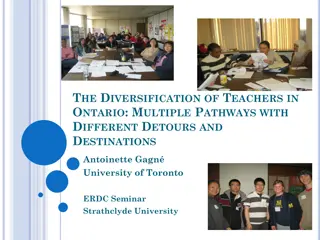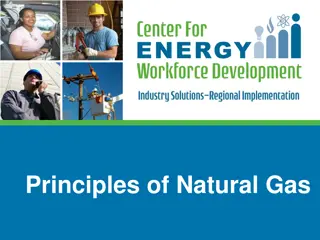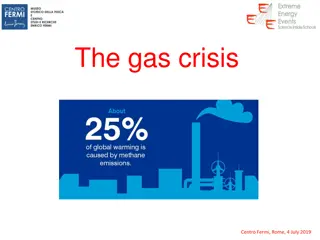Exploring the Diversification of Gas Networks
Interest in diversifying traditional gas pipeline systems with new gases like hydrogen, biogas, and synthetic natural gas is on the rise due to environmental and economic drivers. This shift towards alternative gases offers solutions for energy storage, greenhouse gas emissions mitigation, and utilizing surplus electrical energy. Regulatory agencies are still determining maximum hydrogen rates, while the integration of biogas, biomethane, and synthetic natural gas presents innovative opportunities for the future of energy infrastructure.
Download Presentation

Please find below an Image/Link to download the presentation.
The content on the website is provided AS IS for your information and personal use only. It may not be sold, licensed, or shared on other websites without obtaining consent from the author. Download presentation by click this link. If you encounter any issues during the download, it is possible that the publisher has removed the file from their server.
E N D
Presentation Transcript
Transmission committee SG1 Chapter 1.3 Other gases in traditional pipeline systems, in kind and quality
WHY new gases in the networks? The interest in diversifying the use of existing natural gas infrastructure with other gases, has increased substantially in recent years. This motivation has mainly two drivers, the first associated with environmental issues and the second of economic nature. The utilization of pipelines in large scale to transport a gaseous fluid is essentially limited to natural gas, carbon dioxide (CO2) and hydrogen (H2). In terms of CO2 transport, there are two main alternatives, one associated with the enhanced oil recovery and the other one with the mitigation of greenhouse gases emissions. On the other hand, the H2 transport is related with energy storage, using of surplus electrical energy to produce and inject H2 into the pipeline and for use as a fuel. FUELING THE FUTURE WITH GAS 2
Focus on hydrogen In terms of hydrogen fraction that is tolerated in the natural gas transmission network, most regulatory agencies do not specify limits. The determination of a maximum hydrogen rate is still a research topic for gas industry. As long as hydrogen has a lower energy density, the limits are indirectly established through the ranges that define the calorific value of the gas. Border connections is a main concern for transmission companies, as long as, there are different requirements in terms of gas quality among the countries. There should be an integrated effort to harmonize the requirements of gas quality in order to create alternatives of use of the existing natural gas infrastructure. FUELING THE FUTURE WITH GAS 3
Biogas, Biomethane and Synthetic Natural Gas Biogas is the gas produced from a biological source. It can be produced by anaerobic digestion of organic matter (manure, sewage sludge, straw, municipal waste) in the absence of oxygen. Biogas from fermentable biological source is composed essentially of methane and carbon dioxide with traces of contaminants. This gas can be upgraded to a product that consists almost entirely of methane in concentrations of 95% to 97%, and is known as upgraded biogas or biomethane. Biomethane can also be obtained by gasification of biomass : a high temperature, (no oxygen) produces a syngas. It can be clean and refined up to obtain a biom thane. The introduction in the same equipment of waste (with carbon : plastic, rubbers .) can give the same result, but it can t be called biom thane.It is called synthetic methane. Synthetic natural gas is also obtained by a chemical process also called methanation. Methanation is an artificial process to combine carbon dioxide with hydrogen to produce pure methane. The reaction can be obtained by a catalytical or biological device. FUELING THE FUTURE WITH GAS 4
From renewable energies to synthetic natural gas Frequently, the wind and solar generation plants are removed from grid to avoid overloading the electricity system. One possible solution for this problem is to use the surplus electrical energy in the production of hydrogen through the concept know as Power-to-Gas. This solution can avoid to build oversized electrical grid, up to absorb such production surpluses, and convert them to gas. FUELING THE FUTURE WITH GAS 5
Power to Gas case study in the French context General introduction The Power to Gas technology provides an innovative solution by transforming surplus supplies of electricity from wind and solar sources into synthesized gas, a carbon-neutral gas that can be injected in full into the natural gas network. Electrolysis : 2H2O 2 H2 + O2 Methanation : CO2 + 4 H2 CH4 + 2 H2O FUELING THE FUTURE 6
Description of the philosophy and of the gases Green hydrogen will be produced using two electrolyzers involving different technologies, from 100% renewable energy. The CO2 necessary will be captured on a nearby industrial site. In the light of the performance levels shown by the demonstrator, the partners will work on the future technical and economic standards of a full-sized installation of this type. FUELING THE FUTURE WITH GAS 7
Jupiter 1000 project INNOVEX WINDMILLS The project has 8 French partners: Grt Gaz, Atmostat, the CEA, CNR, Leroux and Lotz Technologies, McPhy Energy, TIGF and the Grand Port Maritime of Marseille. FUELING THE FUTURE WITH GAS 8
General experience and Long term view There are already twenty or so demonstrators in use in Europe, mainly in Germany, the Jupiter 1000 project, with a power rating of 1 MWe, is the first installation at this production scale in France. In 2025, excess renewables power could reach big values, divided between short period and long period surpluses. Yet, between all existing storage technologies, the Power to Gas seems to be today, the most appropriate technology for long time storage. Status point : the 8 project participants have finalized the project agreement and have launched engineering studies and permitting applications during the first quarter of 2016. FUELING THE FUTURE WITH GAS 9
Benefits/advantages The project will allow the participants to : To validate technologies and their performance in an integrated system. To release a new methanation technology (for the first time in a pre- industrial size). To design interfaces and an injection & gas mixing unit for transmission grid injection. To be ready to connect safely Power to Gas unit to the transmission grid To launch a new industry for energy storage To identify technical constraints of such system in operation Advantages of the power to gas solution the enormous transportation and storage capacity of the existing infrastructure including underground storage facilities can be used directly it helps to avoid the construction of new electricity transmission lines. FUELING THE FUTURE WITH GAS 10
Biomethane injection in transmission networks Situation in France Legal Law on Energy Transition and green growth (August 2015): renewable gas = 10% of consumption in 2030 Development With regard to renewable gases, in 2015, 17 facilities were able to inject 82 GWh of biomethane into the entirety of France s gas grids (15 on distribution networks and 2 on transmission networks). Since January 2016, 6 new plants have been injected biomethane into networks (September 2016 data), FUELING THE FUTURE WITH GAS 11
Biomethane injection in transmission networks In September 2015, GRTgaz connected a major biomethane production unit to its network. In November 2015, TIGF put into service, on its transmission network, the largest biomethane production unit in France to date. For the time being all the projects have the restriction of no biomethane injection in the main transmission network, as there is limited experience in the operation of these injection points (so a condition to have also consumptions not too far from the injection points has been established) and the field data that will be accumulated in the coming months/years will allow the development of an analysis of the operation of these plants. FUELING THE FUTURE WITH GAS 12
Conclusions Limited experience in the operation of these injection points, so limitation to a local consumption There are specific issues (legal, technical) that are to be highlighted and analysed for each country (e.g. limitation in pesticides, injection in storages, ) Need of data to provide a complete picture at European/worldwide level. FUELING THE FUTURE WITH GAS 13























